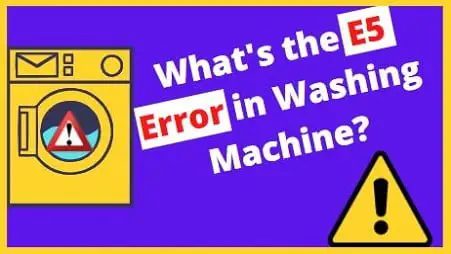If your washing machine is displaying the E1 error code, it means there is a problem with the water supply.
The good news is that this problem can often be fixed by checking a few simple things.
In this blog post, we will walk you through the causes of the E1 error and how to fix it.
Here’s what you will learn:
- What E1 error means
- Steps to get rid of the E1 error
- Commonly asked questions
- And more…
What is the E1 Error on a washing machine?
The E1 error on a washing machine is an indication that there is a problem with the water supply. The most common causes of the E1 error are a clogged inlet valve, a failed inlet valve, or maybe an issue with failed water level sensor. Sometimes, a clogged washing machine pressure switch hose or a loose connection can also result in the E1 error.
Let’s take a look at each cause and possible solutions
Causes of the E1 Error & Solution
There are several reasons why your washing machine may be displaying the E1 error code.
Clogged Inlet Valve
The inlet valve is a key part of the washing machine that helps to control the flow of water into the machine. If this valve becomes clogged, it can prevent the machine from filling with water and result in an E1 error code.
There are several ways to clear a clogged inlet valve, the simplest way to clear the clogged inlet valve is to:
- Turn off the washer and unplug it.
- Take off the water valves.
- Remove any debris that may be blocking the valve.
- Brush it with distilled white vinegar.
- Once the valve is clear, reattach the water valves and turn on the power to the washer.
- If this does not solve the problem, you may need to replace the inlet valve.
Failed Inlet Valve
If your inlet valve has failed, it will need to be replaced. You can purchase a new inlet valve from either a hardware store or online retailers.
The easiest way to identify if the Inlet valve has failed is to check for any water leaks. If clogging and leaking are not a problem, there are high chances that the inlet valve has gone bad and it needs a replacement.
Pressure Switch Hose is Damaged or Clogged
Another possible cause of the E1 error code is a damaged or clogged pressure switch hose. This pressure switch hose helps to regulate the water level in the washing machine.
If the pressure switch hose is clogged try following the instructions in the below video.
Water Level Sensor
The water level sensor is responsible for detecting the water level in the washing machine. If this sensor is not working correctly, it can cause the E1 error code to show up.
To test if the water level sensor is working correctly, unplug the washing machine and remove the control panel.
Once you have access to the water level sensor, test it with a multimeter. If the sensor is not reading correctly, it will need to be replaced.
Even though it’s recommended to take a professional’s help in checking the sensors, just in case you want to be a little adventurous, follow the below video.
Final Thoughts
Basic troubleshooting at home is good if the problem is not that big. But, if the issue still persists, it is always better to take professional help as they will be able to identify the problem quickly and fix it without causing any further damage.
We hope this blog post was helpful in troubleshooting the E1 error code on your washing machine. If you have any further questions, please feel free to check out our dedicated FAQ section on washing machines.
Also Read: How to clean mold from the washing machine?
Frequently Asked Questions
What are the best pipes for a washing machine that are recommended?
The best pipes for a washing machine are those that are made of PVC or metal. These materials are less likely to break down over time and will provide a durable connection for your washing machine.
What are some other Error Codes that may show up on my washing machine?
Other common error codes that may show up on your washing machine include:
E2 – This code indicates that there is a problem with the water temperature sensor.
E3 – This code indicates that there is a problem with the water level sensor.
Can a water inlet valve get clogged?
Yes, a water inlet valve can become clogged over time. This can happen if there is sediment build-up in the valve or if the valve is not properly maintained. If you notice that your washing machine is not filling up with water as quickly as it used to, it may be a sign that the inlet valve is starting to become clogged.
What are some signs that my water level sensor is not working correctly?
Some signs that your water level sensor is not working correctly include:
1.) The washing machine does not fill up with water.
2.) The washing machine does not sense when the laundry basket is full of clothes.
3.) The washing machine does not automatically stop when the laundry basket is full of clothes.
If you notice any of these signs, it is a good idea to test the water level sensor with a multimeter. If the sensor is not reading correctly, it will need to be replaced.

